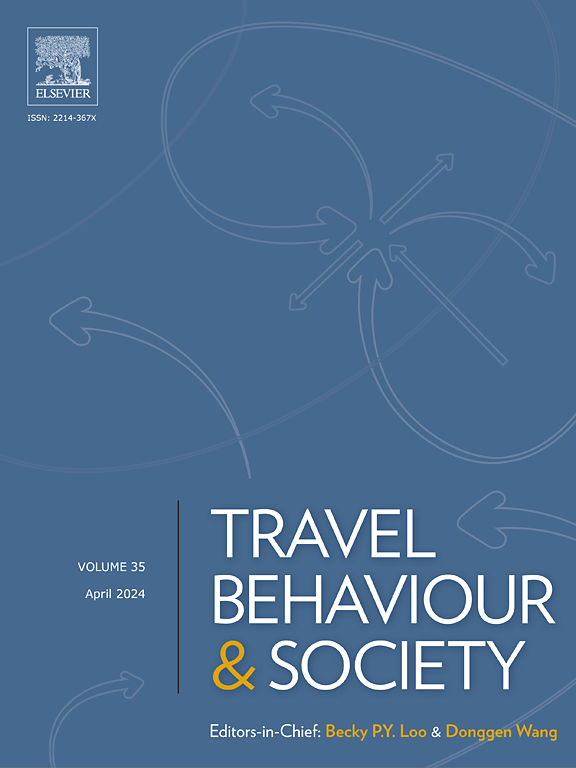邮包收货人在集体运输中的机会调查:行为分析
IF 5.7
2区 工程技术
Q1 TRANSPORTATION
引用次数: 0
摘要
本文调查了雇佣包裹接收者的想法,以更有效的电子商务最后一英里交付(LMD),特别是在利用替代交付点(如包裹储物柜)的人群运输(CS)计划中。这种概念的潜力在操作上很重要,特别是当收件人越来越有兴趣通过新的LMD计划接收包裹(无论是在家门口还是在其他地点)时。因此,本研究提出了一种新形式的服务人群,称为储物柜接收者,当他们从这些设施中挑选自己的物品时,他们愿意将包裹从储物柜传递给他们的邻居。为了有效地规划这样一个系统,从储物柜接收者的角度评估CS交付作业的吸引力至关重要。因此,我们调查了悉尼大都会区内的公民,并模拟了储物柜接收者参与该计划的意图(即参与模型)和他们接受CS任务的可能性(即接受模型)。我们的分析表明,虽然人口因素很重要,但对包裹储物柜的熟悉程度、送货到家的频率以及他们对可持续性的态度是影响人们参与计划意愿的重要因素。此外,我们开发了一个使用潜在类别(LC)选择结构的接受模型,该模型确定了受访者中的两个主要类别:第1类(有条件的热情用户)和第2类(犹豫用户)。第一类表现出更大的CS任务倾向,特别是在具有包裹寄存经验和中高收入的兼职员工中。第2类,虽然最初犹豫不决,但可能会对增加的激励做出积极的反应。对接受意愿(WTA)的分析揭示了集群之间不同的薪酬偏好,强调了量身定制薪酬结构的重要性。本文章由计算机程序翻译,如有差异,请以英文原文为准。
Investigating Opportunities in Crowd-Shipping by Parcel Receivers: A Behavioural Analysis
This paper investigates the idea of hiring parcel receivers for more effective e-commerce Last Mile Delivery (LMD), specifically within Crowd-Shipping (CS) initiatives that utilise alternative delivery points such as parcel lockers. The potential of such a concept is operationally important, particularly when receivers are increasingly interested in receiving parcels (either at their doorstep or at an alternative location) via new LMD initiatives. Therefore, this study proposes a new form of an in-service crowd, called at-locker receivers, who are willing to deliver parcels from lockers to their neighbours when they pick their own items from such facilities. To effectively plan such a system, assessing CS delivery job attractiveness from the perspective of at-locker receivers is crucial. Accordingly, we surveyed citizens within the Sydney Metropolitan Area and modelled at-locker receivers’ intention to participate in the program (i.e., participation model) and their likelihood of accepting CS tasks (i.e., acceptance model). Our analysis reveals, while demographic factors are important, familiarity with parcel lockers, frequency of home delivery, and their attitude towards sustainability are important factors influencing people’s willingness to participate in the program. Furthermore, we developed an acceptance model using a Latent Class (LC) choice structure, which identified two major classes among the respondents: Class 1 (conditionally enthusiastic users) and Class 2 (hesitant users). Class 1 exhibits a greater propensity for CS tasks, particularly among part-time employees with parcel locker experience and with middle-to-high level income. Class 2, though initially hesitant, may respond favourably to increased incentives. Analysis of willingness-to-accept (WTA) reveals distinct compensation preferences between clusters, emphasising the importance of tailored compensation structures.
求助全文
通过发布文献求助,成功后即可免费获取论文全文。
去求助
来源期刊

Travel Behaviour and Society
TRANSPORTATION-
CiteScore
9.80
自引率
7.70%
发文量
109
期刊介绍:
Travel Behaviour and Society is an interdisciplinary journal publishing high-quality original papers which report leading edge research in theories, methodologies and applications concerning transportation issues and challenges which involve the social and spatial dimensions. In particular, it provides a discussion forum for major research in travel behaviour, transportation infrastructure, transportation and environmental issues, mobility and social sustainability, transportation geographic information systems (TGIS), transportation and quality of life, transportation data collection and analysis, etc.
 求助内容:
求助内容: 应助结果提醒方式:
应助结果提醒方式:


